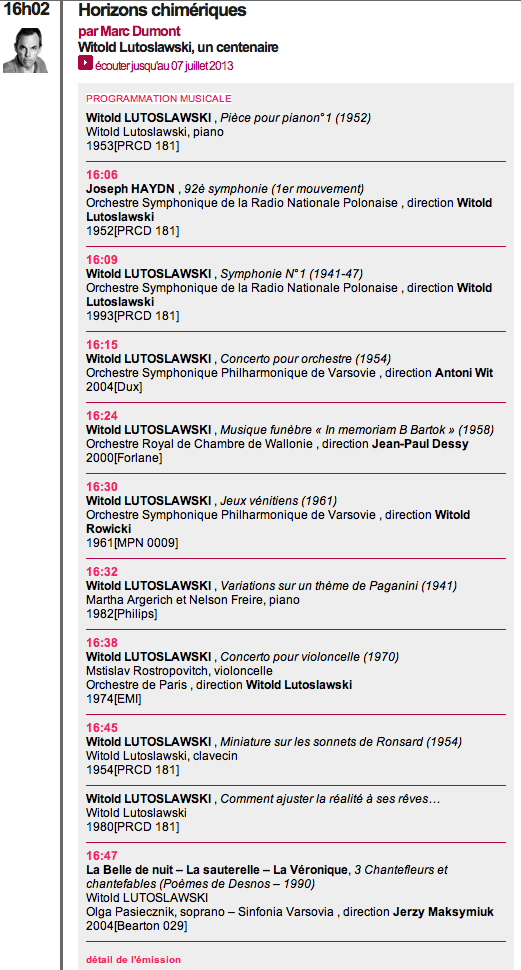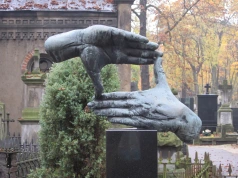• Górecki: Refren, **27 October 1965
Sunday, 27 October 2013 Leave a comment
Before I first went to Poland, my fellow student Jim Samson brought back from Warsaw an LP of music by Henryk Mikołaj Górecki. It blew our socks off. Released a couple of years earlier, Polskie Nagrania ‘Muza’ XL 0391 (reissued over 25 years later on Olympia OCD 385 as ‘The Essential Górecki’) contained music the like of which neither of us had heard before. There was the brief, Webernian Epitafium (1958), the explosive Scontri (Collisions, 1960), the incantatory Genesis II: Canti strumentali (1962) and the comparatively restrained Refren (Refrain, 1965). Thrilling though the first three pieces were, it was the last work that made the most profound impression. Here is that recording of 1967, by the the Great Symphony Orchestra of Polish Radio (WOSPR) conducted by Jan Krenz.
 Over the summer of 2013, information emerged about the commissioning and premiere of Refren (which took place in Geneva on this date 48 years ago, Wednesday 27 October 1965, with the Orchestre de la Suisse Romande conducted by Pierre Colombo – it had been commissioned for the Centenary of the International Telecommunications Union, which was and still is based in Geneva). This little story unfolded after I was contacted in early June by the Head of the Library and Archives service of the ITU, Kristine Clara. She had come across a photograph in the October 1965 issue of the ITU’s Communication Journal and could find no further trail of the ITU’s connection with Refren. “Could I help?”.
Over the summer of 2013, information emerged about the commissioning and premiere of Refren (which took place in Geneva on this date 48 years ago, Wednesday 27 October 1965, with the Orchestre de la Suisse Romande conducted by Pierre Colombo – it had been commissioned for the Centenary of the International Telecommunications Union, which was and still is based in Geneva). This little story unfolded after I was contacted in early June by the Head of the Library and Archives service of the ITU, Kristine Clara. She had come across a photograph in the October 1965 issue of the ITU’s Communication Journal and could find no further trail of the ITU’s connection with Refren. “Could I help?”.
This must be one of the strangest photographs connected with a new score. No sign of the composer, none of the conductor or orchestral musicians. Instead, there are three now-forgotten figures from the worlds of politics and the unions looking at Górecki’s manuscript (although it looks more like one of the orchestral parts than the full score). It is possible that Górecki had been invited, but I know that he was in Poland on the day that this photograph was taken and that he was ill at home on the day of the premiere six weeks later. Kristine Clara also wondered where the score was – it was not in the ITU archives. As far as I am aware, it went back to Poland, to the composer and to his publisher PWM, who brought it out in 1967. As to the commission, my guess is that it was engineered by the Polish government and its Ministry of Culture. It was a very important moment in Górecki’s life: his first foreign commission and premiere.
One piece of information that I could now furnish concerned the precise dates of Refren‘s composition. The dates that Górecki had given were May-June 1965. Having recently looked at his diaries, I was able to say that he started work on the piece on 26 April and finished it on 30 June.
As our email conversation progressed, Kristine Clara unearthed other information, this time about the premiere. The Swiss Radio listings for 27 October indicate that Refren was broadcast live.
She also came across the catalogue card for the Swiss Radio tape of the premiere, which indicated that not only was it broadcast live but, contrary to the BBC’s practice at the time, was also recorded, enabling it to be rebroadcast on New Year’s day 1966.
I have not yet been able to determine if this tape still exists. It would be fascinating to hear it, not least to verify the unexpected comment – with exclamation mark – written on the card: ‘Attention: rumeurs dans le public!’ (Warning: audience noise!).
Kristine Clara also unearthed several relevant items from the Journal de Genève – ‘de notre envoyé spécial’. This turns out to be Franz Walter, a music critic and broadcaster best known today for having interviewed the pianist Dinu Lipatti less than three months before his death in 1950 (http://www.youtube.com/watch?v=NqftMxn1PrI). Walter had been at the ‘Warsaw Autumn’ festival a few weeks before the premiere of Refren; I may come back at a later date to his two reviews of the festival in Journal de Genève (18 and 27 October). More pertinent here is his review of the Suisse Romande concert on 27 October, which appeared in Journal de Genève the following day (it is the only review of the premiere of which I am aware). I will pass over Walter’s enthusiastic response to the performance of Prokofiev’s First Violin Concerto by the young Claire Bernard. His response to Refren is revealing. His touchstone here was the performance he had heard in Warsaw on 23 September of Górecki’s Elementi for violin, viola and cello (1962), in a performance by Ensemble Instrumental Musiques Nouvelles de Bruxelles.
Pierre Colombo, who had shaped the concerto’s accompaniment with great care – after a Mozart symphony which I could not hear [maybe Walter was returning to the hall having just introduced the concert on air] – then presented the world premiere of a work by the Pole Henryk Górecki. The Warsaw Festival had just recently aired a string trio by this composer, a trio in which the players were induced to utter all the most incongruous and horrifying sounds that one can draw from a string instrument, yielding also to a “bruitist” mode that was very much in evidence at this recent festival. The point of such a work could only be to get on the nerves of the listener. The work which Pierre Colombo presented to us, with large orchestral forces, pursued in short the same goal, though by different means. Long chordal aggregates, tirelessly repeated and punctuated by brief… how shall I put it… gusts of wind from the brass, frantic barking from these same brass, splashes from the strings, explosions from the timpani, such is the material which furnishes Refrains [sic].
The nervous effect was produced. In the event, it found expression in laughter. But our public is not yet used to this music. Elsewhere people listen with great seriousness (and for my part with profound boredom). F.W.
There are some inconsistent aspects of Walter’s account, especially in the short second paragraph, but it is clear that he found Górecki’s new piece insupportable and gives the clue to the ‘audience noise’ mentioned on the Swiss Radio catalogue card. I wonder how widespread this laughter was. One has to marvel, though, at Walter’s response. He had heard much more rebarbative music in Warsaw a few weeks earlier, and Górecki’s Refren is not that far removed in aesthetic from Messiaen’s Les offrandes oubliées, composed 35 years earlier. It marks, as we now know, the turning point from the overt dynamism of the preceding decade to the largely contemplative mode of his subsequent music. But to contemporary ears (or at least Walter’s) it sounded as bad as the earlier pieces.


















